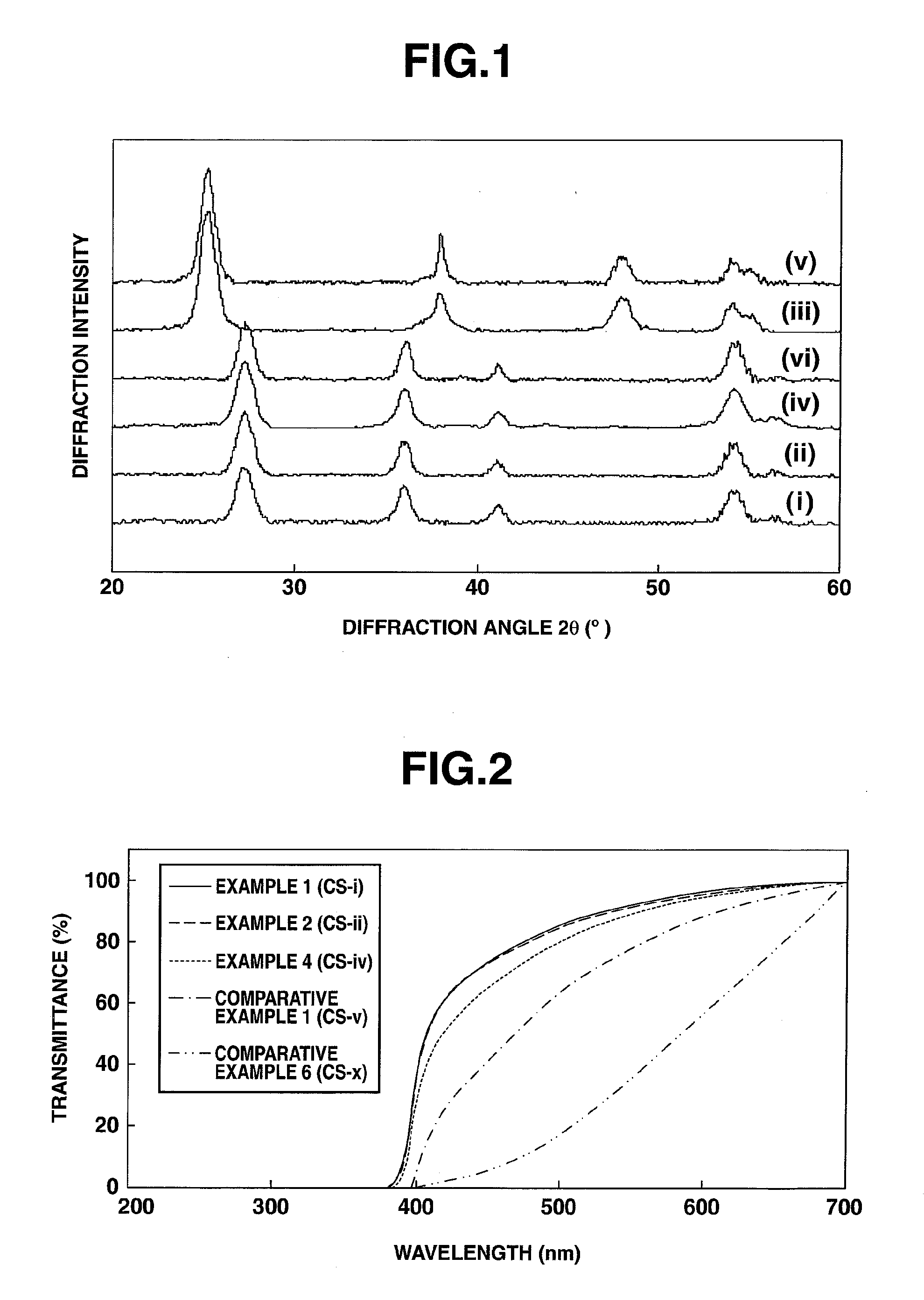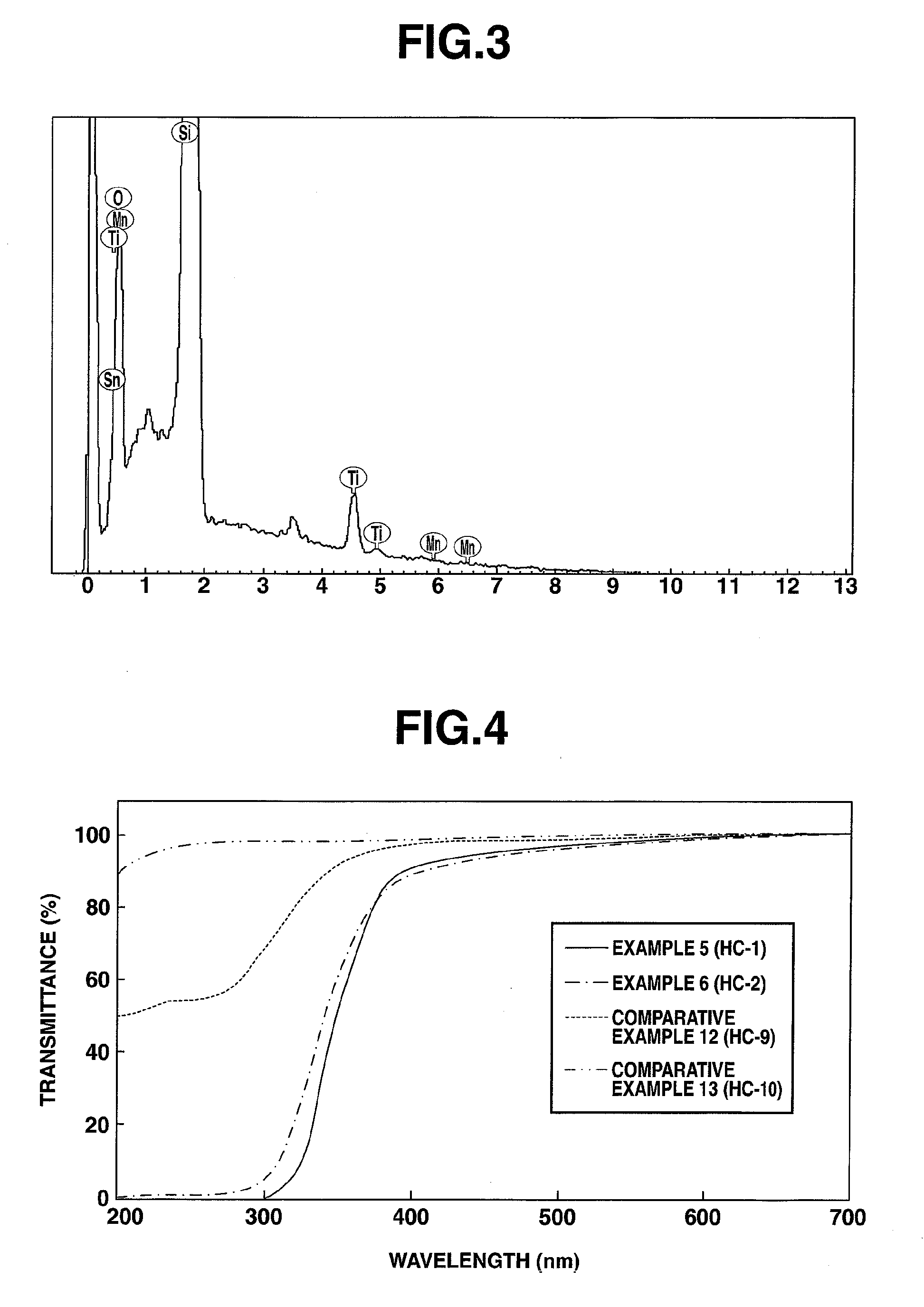Core/shell type tetragonal titanium oxide particle water dispersion, making method, uv-shielding silicone coating composition and coated article
a technology of titanium oxide and water dispersion, which is applied in the direction of instruments, lighting and heating equipment, transportation and packaging, etc., can solve the problems of poor weather resistance of cured films, poor composition, and poor weather resistance of compositions
- Summary
- Abstract
- Description
- Claims
- Application Information
AI Technical Summary
Benefits of technology
Problems solved by technology
Method used
Image
Examples
synthesis example 1
Preparation of Titanium Oxide Dispersion (i) (4 Mol % Tin and 0.5 Mol % Manganese Relative to 100 Mol % Titanium)
[0181]To 66.0 g of 36 wt % titanium(IV) chloride aqueous solution (TC-36 by Ishihara Sangyo Kaisha, Ltd.) were added 1.8 g of tin(IV) chloride pentahydrate (Wako) and 0.12 g of manganese(II) chloride tetrahydrate (Wako). They were thoroughly mixed and diluted with 1,000 g of deionized water. To the metal salt aqueous solution mixture, 300 g of 5 wt % aqueous ammonia (Wako) was gradually added for neutralization and hydrolysis, yielding a precipitate of titanium hydroxide containing tin and manganese. This titanium hydroxide slurry was at pH 8. The precipitate of titanium hydroxide was deionized by repeating deionized water addition and decantation. To the precipitate of titanium hydroxide containing tin and manganese after deionization, 100 g of 30 wt % aqueous hydrogen peroxide (Wako) was gradually added, whereupon stirring was continued at 60° C. for 3 hours for full re...
synthesis example 2
Preparation of Titanium Oxide Dispersion (ii) (6 Mol % Tin and 2.0 Mol % Manganese Relative to 100 Mol % Titanium)
[0183]A titanium oxide dispersion (ii) was obtained as in Synthesis Example 1 except that 2.6 g of tin(IV) chloride pentahydrate and 0.50 g of manganese(II) chloride tetrahydrate were added.
example 1
Preparation of Core / Shell Type Titanium Oxide Particle Water Dispersion (CS-i)
[0198]A separable flask equipped with a magnetic stirrer and thermometer was charged with 100 parts of titanium oxide dispersion (i) in Synthesis Example 1, 10 parts of ethanol, and 0.2 part of ammonia at room temperature, followed by magnetic stirring. The separable flask was placed in an ice bath and cooled until the temperature of the contents reached 5° C. Tetraethoxysilane, 1.8 parts, was added to the separable flask, which was mounted in μReactor EX (Shikoku Instrumentation Co., Inc.) where microwave was applied at a frequency 2.45 GHz and a power 1,000 W for 1 minute while magnetic stirring was continued. The thermometer was monitored during the microwave heating step, confirming that the temperature of the contents reached 85° C. After heating, the reactor was cooled to room temperature in a water bath. The liquid was poured into a round bottom flask and concentrated by batchwise vacuum distillatio...
PUM
| Property | Measurement | Unit |
|---|---|---|
| volume cumulative distribution diameter D50 | aaaaa | aaaaa |
| volume cumulative distribution diameter D50 | aaaaa | aaaaa |
| molar ratio | aaaaa | aaaaa |
Abstract
Description
Claims
Application Information
 Login to View More
Login to View More - R&D
- Intellectual Property
- Life Sciences
- Materials
- Tech Scout
- Unparalleled Data Quality
- Higher Quality Content
- 60% Fewer Hallucinations
Browse by: Latest US Patents, China's latest patents, Technical Efficacy Thesaurus, Application Domain, Technology Topic, Popular Technical Reports.
© 2025 PatSnap. All rights reserved.Legal|Privacy policy|Modern Slavery Act Transparency Statement|Sitemap|About US| Contact US: help@patsnap.com



